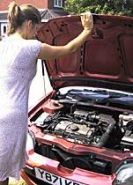Show Me/Tell Me Questions
Since September 2003, candidates for the practical driving test are required to answer
2 vehicle safety check questions. Vehicle Safety Checks have always been part of the officially recommended syllabus for
learning to drive.
As you approach your driving test, your instructor will guide you through each vehicle safety
check step-by-step. Carrying out basic preventative maintenance by being
able to identify the various fluid reservoirs and how to check their
level marks is essential for preventing vehicle breakdowns in everyday
motoring and not just for the driving test.
The source material is to
be found in the Driver & Vehicle Standards Agency (DVSA) publication "Driving the
essential skills" and "The official DVSA driving test". Advice and
information on how to carry out vehicle safety checks can also be found
in the manufacturer's handbook.
Your examiner will ask you one:
- "Tell Me" question at the start of your test, before you start driving, where you explain how to carry out a safety task.
- "Show Me" question where you show how to carry out a safety task whilst you are driving.
Tell Me Questions
- Tell me how you would check that the brakes are working before starting a journey.
Brakes should not feel spongy or slack. Brakes should be tested as you set off. Vehicle should not pull to one side.
- Tell me where you would find the information for the recommended tyre pressures for this car and how tyre pressures should be checked.
Manufacturer’s guide, use a reliable pressure gauge, check and adjust pressures when tyres are cold, don’t forget spare tyre, remember to refit valve caps.
- Tell me how you make sure that your head restraint is correctly adjusted so it provides the best protection in the event of a crash.
The head restraint should be adjusted so the rigid part of the head restraint is at least as high as the eye or the top of the ears, and as close to the back of the head as comfortable. Note: some
restraints might not be adjustable.
- Tell me how you would check the tyres to ensure that they have sufficient tread depth and that their general condition is safe to use on the road.
No cuts and bulges, 1.6mm of tread depth across the central ¾ of the breadth of the tyre and around the entire outer circumference of the tyre.
- Tell me how you would check that the headlights & tail lights are working. You don't need to exit the vehicle.
Operate switch (turn on ignition if necessary), then walk round the vehicle.
- Tell me how would know if there was a problem with the anti-lock braking system.
Warning light would illuminate if there is a fault with the anti-lock braking system.
- Tell me how you would check that the direction indicators are working. You don't need to exit the vehicle.
Explain you'd operate the switch (turn on ignition if necessary), then walk round the vehicle.
- Tell me how you would check that the brake lights are working on this car.
Explain you'd operate brake pedal, make use of reflections in windows or doors, or ask someone to help.
- Tell me how you would check that the power assisted steering is working before starting a journey.
If the steering becomes heavy the system may not be working properly. Before starting a journey two simple checks can be made. Gentle pressure on the steering wheel, maintained while the engine
is started, should result in a slight but noticeable movement as the system begins to operate. Alternatively turning the steering wheel just after moving off will give an immediate indication that the power assistance is functioning.
- Tell me how you would switch on the rear fog light(s) and explain when you would use it/them. You don't need to exit the vehicle.
Operate switch (turn on dipped headlights and ignition if necessary). Check warning light is on. Use when visibility is reduced to less than 100 metres.
- Tell me how you switch your headlights from dipped to main beam and explain how you would know the main beam is on.
Operate switch (turn on ignition is necessary) and check with main beam warning light.
- Open the bonnet and tell me how you would check that the engine has sufficient oil.
Identify dipstick / oil level indicator, describe check of oil level against the minimum and maximum markers.
- Open the bonnet and tell me how you would check that the engine has sufficient engine coolant.
Identify high and low level markings on header tank where fitted or radiator filler cap, and describe how to top up to correct level.
- Open the bonnet and tell me how you would check that you have a safe level of hydraulic brake fluid.
Identify reservoir, check level against high and low markings.
Show Me Questions
- When it's safe to do so, can you show me how you wash and clean the rear windscreen?
- When it's safe to do so, can you show me how you would switch on your dipped headlights?
- When it's safe to do so, can you show me how you would switch on your dipped headlights?
- When it's safe to do so, can you show me how you would set the rear demister?
- When it's safe to do so, can you show me how you would operate the horn?
- When it's safe to do so, can you show me how you would demist the front windscreen?
- When it's safe to do so, can you show me how you would open and close the side window?



